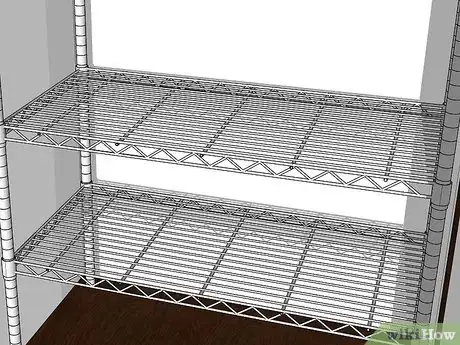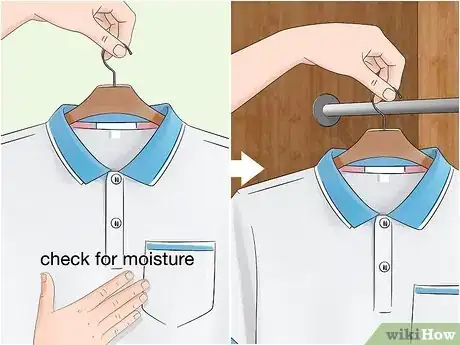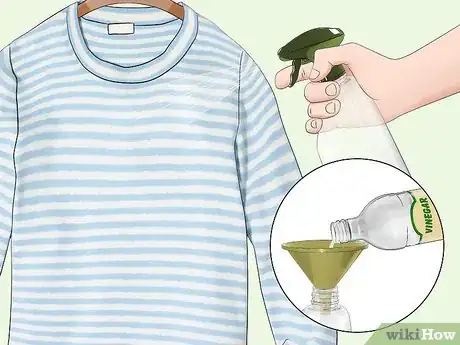This article was co-authored by Sergey Paramonov and by wikiHow staff writer, Janice Tieperman. Sergey Paramonov is a Laundry Expert and the Co-Founder of FreshRobe laundry and dry-cleaning delivery service based in San Francisco, California. Sergey has over 10 years of experience in the industry and specializes in laundry, dry cleaning services, and delivery services. His facilities use energy and water-efficient technology to prioritize a sustainable, professional cleaning service for all types of garments.
There are 11 references cited in this article, which can be found at the bottom of the page.
This article has been viewed 39,102 times.
If you’ve had run-ins with mildew or damp clothes, you’re definitely not alone. While unwanted moisture can seem unavoidable in your wardrobe and garments, there are few ways you can protect your clothing from developing pesky mold. If you’re looking for a short-term solution, try using a cleaning product designed to repel or absorb moisture, like charcoal or silica gel. If your clothes have already succumbed to mold or mildew, there’s no need to panic—with a few household cleaners, you can sanitize and restore your garments in no time!
Steps
Trying Quick Fixes
-
1Spritz your clothes with a water repellent spray. Search in a home improvement or department store for a water repellent spray product. While commonly used by campers and hikers, you can also use this product to give your clothing a protective, moisture-resistant layer. Spray it all over the outside of your clothes before storing them in your wardrobe, and you may see positive results.[1]
- A lot of these sprays are made with silicone. If you have an allergy, this product might not be a good option for you.
-
2Use silica gel packets to absorb moisture. Shop online for a small collection of silica gel packets, which naturally soak up moisture wherever they’re placed. While they aren’t a foolproof solution, place these packets in the pockets and hoods of your garments to soak up moisture and prevent your clothes from becoming moldy.[2]
- If you can’t find these packets online, look in a store that sells industrial supplies.
- A local school may have silica gel packets on hand.
- For the packets to absorb moisture, it's important to keep your clothes in a closed environment. Otherwise, the impact on moisture will be minimal.
Advertisement -
3Store a tin of charcoal in your closet to absorb moisture. Fill a large container or coffee can with plain charcoal briquettes that aren’t designed for grilling. Secure the lid on the coffee can or other container, then poke the top a few times. Keep this can in your closet to soak up moisture and keep your clothes dry![3]
- You can buy natural charcoal online or in a home improvement store.
- Charcoal can work as an impromptu dehumidifier.
- Charcoal naturally soaks up moisture, which makes it a quick and easy solution for your closet.
-
4Set up a fan in your closet if your clothing looks or feels moist. Find a wall outlet near your wardrobe and plug a box fan in. Situate the fan so it’s pointed at the front of the wardrobe. If you suspect that your wardrobe is overly humid, turn the fan on to a low setting and let it air out the area.[4]
- You can also open a window to air out your wardrobe.
- If only a few clothing items look damp, this might not be necessary.
-
5Keep your closet door open even when you’re not in the room. Get in the habit of keeping your wardrobe open, regardless of the time of year. If you’re going on vacation or heading out for the weekend, leave your wardrobe open so it can air out while you’re away.[5]
Monitoring and Adjusting the Wardrobe
-
1Keep your wardrobe at a consistent, cool temperature. Check your thermostat to make sure that the temperature isn’t spiking and dropping constantly. [6] Try to keep your wardrobe temperature beneath 23 °C (73 °F) so your clothing can stay as fresh as possible.[7]
- If the temperature changes a lot, your clothes might lower in quality overall.
-
2Hang a low-wattage bulb in the closet to provide extra heat to the area. Visit a hardware or department store to find a small, 60- to 100-watt lightbulb. If your home’s wiring permits, install the bulb from the ceiling of your wardrobe. Keep this light turned on as often as you can, as it can warm your clothes.[8]
- This works best in smaller closets and wardrobes.
-
3Install a dehumidifier in your wardrobe. Check online or visit a home goods store to find up a dehumidifier that best fits the needs of your home. If your home and wardrobe feels humid constantly, use a dehumidifier to keep the air dry and balanced.[9]
- If you don’t have a dehumidifier, you can also use an air conditioner to keep the air cool and dry.
-
4Install plastic-coated shelves in your closet so moisture doesn’t build up. Look in your local hardware or home improvement store for closet shelving kits. Specifically, search for shelving that’s coated with plastic, which prevents moisture from building up in your closet and around your clothes. Use the instructions to install the shelving, or hire a professional for help.[10]
-
5Scrub away any mold in your closet with detergent. Remove everything from your closet if you notice any mold or spores in the area. At this point, pour a spoonful of all-purpose detergent or soap into a basin of warm water, then dip a sponge into the mixture. Wipe down any moldy sections of your closet to sanitize them and wait an hour or so for your wardrobe to air-dry.[11]
- Don’t put anything back into your closet until the area is dry and no longer smells musty or moldy.
- If you’re dealing with a lot of spores, mix 1 cup (240 mL) of bleach with 1 gallon (3.8 L) of water and use that cleaning solution to clean off the surface.
Taking Sanitary Steps When Handling Your Clothes
-
1Check that your clothes are clean and dry before you hang them up. If your garments still feel wet or damp to the touch, hang them up in an open area so they can air-dry. If you find dirty clothing in your wardrobe, be sure to set it aside so you can wash it.[12]
-
2Rearrange your clothes so they aren’t packed tightly together. Moisture and mildew go hand in hand, especially when your clothes are packed like sardines. Remove any off-season clothes from your closet, and store your fancier garments in perforated bags, which gives them room to breathe.[13]
-
3Clean your clothes with borax to get rid of any mold. Use a small, handheld vacuum to suck up any mold spores from your clothing. Mix 1 cup (204 g) of borax into 1 gallon (3.8 L) of water, then rub the cleaner onto your affected clothing with a bristled brush. Blot away any excess liquid, then let your garment air-dry completely.[14]
- Always check the care labels before cleaning your clothes at home.
-
4Sanitize your clothing naturally with white vinegar. Fill a spray bottle with white vinegar and spritz down any affected clothing. Set a timer for 1 hour to let the vinegar soak into the fabric, then dab at your clothes with a water-soaked rag. Once the vinegar is completely cleaned out of the material, let your clothing air-dry for a few hours.[15]
- Distilled white vinegar is the best product to use for this.
Warnings
Things You’ll Need
Trying Quick Fixes
- Water-repellent spray
- Silica gel packets
- Charcoal briquettes (not soaked in lighter fluid)
- Box fan
Monitoring and Adjusting the Wardrobe
- Dehumidifier
- Low-wattage light bulb
- Plastic-coated shelving
- Detergent
- Water
- Bucket or basin
- Sponge
Taking Sanitary Steps When Handling Your Clothes
- Borax
- Handheld vacuum
- White vinegar
References
- ↑ https://extension2.missouri.edu/gh5928
- ↑ https://extension2.missouri.edu/gh5928
- ↑ https://www.readersdigest.ca/home-garden/tips/5-things-do-charcoal-briquettes/
- ↑ https://www.epa.gov/mold/brief-guide-mold-moisture-and-your-home
- ↑ https://napola.org/resources/Documents/Wardrobe%20Preservation%20Tips%20for%20NAPO.pdf
- ↑ https://napola.org/resources/Documents/Wardrobe%20Preservation%20Tips%20for%20NAPO.pdf
- ↑ https://www.safestore.co.uk/blog/2014/11/how-to-store-your-clothes-long-term/
- ↑ https://extension2.missouri.edu/gh5928
- ↑ https://www.epa.gov/mold/brief-guide-mold-moisture-and-your-home
- ↑ https://www.puroclean.com/blog/how-to-prevent-mold-growth-in-your-closets/
- ↑ https://todayshomeowner.com/how-to-prevent-and-remove-mold/
- ↑ https://www.puroclean.com/blog/how-to-prevent-mold-growth-in-your-closets/
- ↑ https://napola.org/resources/Documents/Wardrobe%20Preservation%20Tips%20for%20NAPO.pdf
- ↑ https://moldpedia.com/mold-removal
- ↑ https://moldpedia.com/mold-removal
- ↑ https://www.kcet.org/home-garden/smart-tips-for-storing-your-winter-clothes
- ↑ https://www.kcet.org/home-garden/smart-tips-for-storing-your-winter-clothes
- ↑ https://www.kcet.org/home-garden/smart-tips-for-storing-your-winter-clothes
- ↑ https://sustaintrust.org.nz/blog/hygrometer
- ↑ https://www.puroclean.com/blog/how-to-prevent-mold-growth-in-your-closets/
- ↑ https://www.puroclean.com/blog/how-to-prevent-mold-growth-in-your-closets/
- ↑ https://www.bobvila.com/slideshow/10-astonishing-feats-you-can-accomplish-with-kitty-litter-49119#winter-outfits





































































